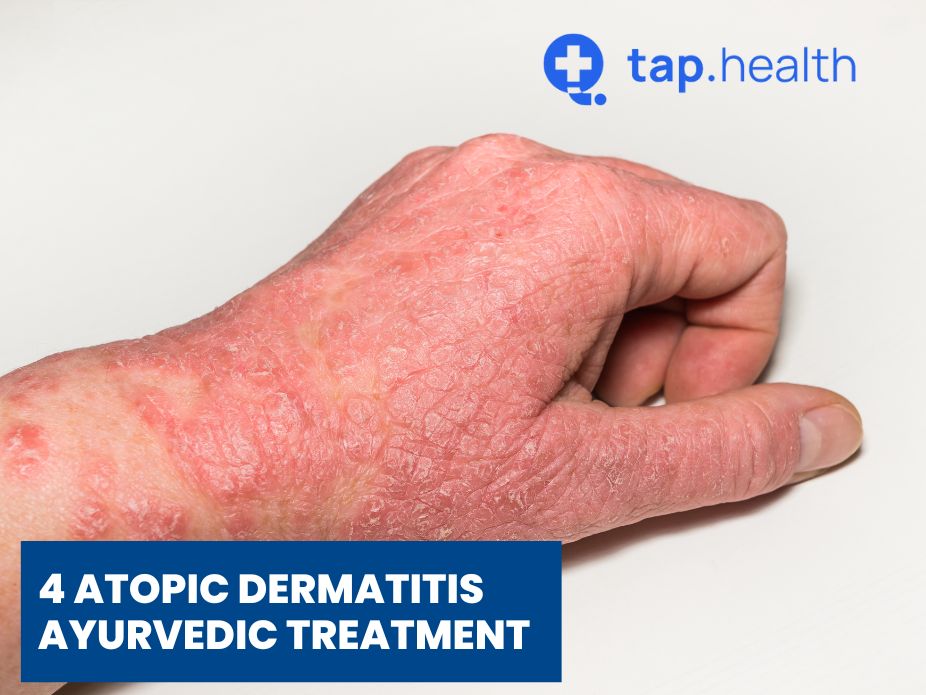Atopic dermatitis, known as eczema, is a chronic inflammatory skin condition characterized by itchy, red, and dry skin. It affects millions of people worldwide, significantly impacting their quality of life. While conventional treatments are available, many seek alternative approaches like Ayurveda for holistic management of this condition. This article will explore the Ayurvedic perspective on atopic dermatitis, including diagnosis, treatments, and supporting scientific evidence.
What is Ayurveda?
Ayurveda, an ancient system of medicine originating in India over 5,000 years ago, focuses on holistic health and wellness. It emphasizes the mind, body, and spirit balance to maintain health and prevent disease. The fundamental principles of Ayurveda revolve around the concept of “Doshas” – Vata, Pitta, and Kapha – which are bioenergetic forces governing physiological and psychological functions.
Principles of Ayurveda
Doshas:
- Vata: Represents air and ether, governing movement and communication. Imbalances can lead to dryness and roughness in the skin.
- Pitta: Comprises fire and water, regulating metabolism and transformation. An excess of Pitta can cause inflammation and redness.
- Kapha: Made of earth and water, responsible for structure and lubrication. Imbalance can result in excessive oiliness and congestion.
Rasa (Taste):
- Ayurveda identifies six tastes – sweet, sour, salty, bitter, pungent, and astringent – each influencing Doshas differently. For instance, bitter and astringent tastes reduce Pitta and Kapha, balancing skin conditions.
Prakriti (Constitution):
- Each individual has a unique constitution based on their dominant Dosha(s), which influences their physical, emotional, and mental traits. Understanding Prakriti is crucial for personalized treatment.
Ayurveda and Skin Health
In Ayurveda, skin health is deeply connected to overall well-being. The skin reflects the body’s internal state, and Doshas’ imbalances often manifest as skin disorders. Maintaining balanced Doshas through diet, lifestyle, and herbal remedies is key to achieving healthy skin.
Ayurvedic Diagnosis of Atopic Dermatitis
The Ayurvedic diagnosis of atopic dermatitis involves assessing the individual’s Dosha imbalances, lifestyle, and environmental factors. A thorough consultation with an Ayurvedic practitioner is essential to tailor a personalized treatment plan.
Identifying Imbalances
- Vata Imbalance:
- Symptoms: Dry, rough, and flaky skin with intense itching.
- Causes: Irregular routines, cold and dry weather, and excessive consumption of dry, raw foods.
- Pitta Imbalance:
- Symptoms: Redness, inflammation, and burning sensation on the skin.
- Causes: Stress, hot weather, spicy and acidic foods, and exposure to heat.
- Kapha Imbalance:
- Symptoms: Thick, oily, and congested skin with a tendency for infections.
- Causes: Sedentary lifestyle, heavy and oily foods, and damp environments.
Consultation with an Ayurvedic Practitioner
A typical consultation involves a detailed examination of the patient’s medical history, diet, lifestyle, and mental state. Practitioners use methods such as pulse diagnosis, tongue analysis, and observation of physical features to identify Dosha imbalances. This comprehensive assessment helps in developing a customized treatment plan targeting the root causes of atopic dermatitis.
4 Effective Ayurvedic Treatments for Atopic Dermatitis
Ayurvedic treatments for atopic dermatitis encompass dietary recommendations, herbal remedies, topical applications, and lifestyle modifications. These holistic approaches aim to restore balance and promote long-term skin health.
1. Dietary Recommendations
Diet plays a crucial role in managing atopic dermatitis in Ayurveda. The focus is on balancing the Doshas through specific dietary choices:
Vata-Pacifying Diet:
- Include warm, moist, and grounding foods such as cooked vegetables, grains, and soups.
- Avoid dry, cold, and raw foods, as well as caffeinated beverages.
Pitta-Pacifying Diet:
- Emphasize cooling and soothing foods like cucumbers, melons, and leafy greens.
- Limit spicy, salty, and acidic foods, along with alcohol and caffeine.
Kapha-Pacifying Diet:
- Opt for light, dry, and warming foods such as legumes, spices, and bitter greens.
- Reduce heavy, oily, and sweet foods, as well as dairy products.
2. Herbal Remedies
Herbs are central to Ayurvedic treatment, offering anti-inflammatory, antimicrobial, and healing properties. Key herbs for atopic dermatitis include:
Neem (Azadirachta indica):
- Known for its antimicrobial and anti-inflammatory properties, neem helps reduce itching and redness.
Turmeric (Curcuma longa):
- Contains curcumin, which has potent anti-inflammatory and antioxidant effects, aiding in skin healing.
Aloe Vera (Aloe barbadensis):
- Soothes and moisturizes the skin, providing relief from dryness and irritation.
Manjistha (Rubia cordifolia):
- Purifies the blood and helps clear skin conditions associated with toxins.
3. Topical Applications
Ayurveda recommends various herbal oils, pastes, and creams for topical application to soothe and heal the skin:
Coconut Oil and Turmeric Paste:
- Mix coconut oil with turmeric powder to create a paste. Apply to affected areas to reduce inflammation and moisturize the skin.
Aloe Vera Gel:
- Fresh aloe vera gel can be applied directly to the skin to cool and hydrate dry, irritated patches.
Neem Oil:
- Neem oil can be used as a massage oil or added to bath water to alleviate itching and prevent infections.
4. Lifestyle Modifications
Incorporating specific lifestyle practices can significantly enhance the effectiveness of Ayurvedic treatments:
Dinacharya (Daily Routine):
- Follow a consistent daily routine, including regular sleep patterns, balanced meals, and self-care practices like Abhyanga (self-massage with warm oil).
Ritucharya (Seasonal Regimen):
- Adapt lifestyle and dietary habits according to seasonal changes to maintain Dosha balance and prevent flare-ups.
Stress Management:
- Practice relaxation techniques such as yoga, meditation, and Pranayama (breathing exercises) to reduce stress, a common trigger for atopic dermatitis.
Hygiene and Environment:
- Maintain good hygiene, avoid harsh soaps and detergents, and create a clean, allergen-free living environment.
Scientific Perspective
While Ayurveda offers a wealth of traditional knowledge and practices, it is essential to explore the scientific perspective to understand its efficacy in managing atopic dermatitis.
Research and Evidence
Several studies have investigated the benefits of Ayurvedic treatments for skin conditions, including atopic dermatitis:
- Neem and Turmeric:
- Aloe Vera:
- Clinical studies have demonstrated aloe vera’s effectiveness in reducing skin dryness and irritation, making it a valuable remedy for atopic dermatitis[^3].
- Herbal Formulations:
- Ayurvedic herbal formulations, such as Triphala and Manjistha, have shown promise in improving skin health by detoxifying the body and reducing inflammation[^4].
- Integrative Approach:
- Combining Ayurvedic treatments with conventional therapies can enhance overall outcomes for patients with atopic dermatitis. Integrative approaches consider the benefits of both systems, offering comprehensive care[^5].
Challenges and Considerations
- Standardization:
- One challenge in Ayurveda is the lack of standardized formulations and dosages, which can affect treatment consistency and reliability.
- Quality Control:
- Ensuring the quality and purity of Ayurvedic herbs and products is crucial to avoid contamination and ensure safety.
- Individual Variation:
- Ayurvedic treatments are highly individualized, which can complicate large-scale scientific evaluations but underscores the importance of personalized care.
FAQ on Atopic Dermatitis Ayurvedic Treatment
1. What is atopic dermatitis?
A chronic inflammatory skin condition characterized by itching, redness, and dryness.
2. How does Ayurveda treat atopic dermatitis?
Through personalized dietary changes, herbal remedies, topical applications, and lifestyle modifications.
3. Are Ayurvedic treatments for atopic dermatitis safe?
Generally safe when guided by a qualified practitioner, but quality and standardization of products are important.
4. Can Ayurvedic treatments be combined with conventional medicine?
Yes, integrating both can enhance overall outcomes for managing atopic dermatitis.




